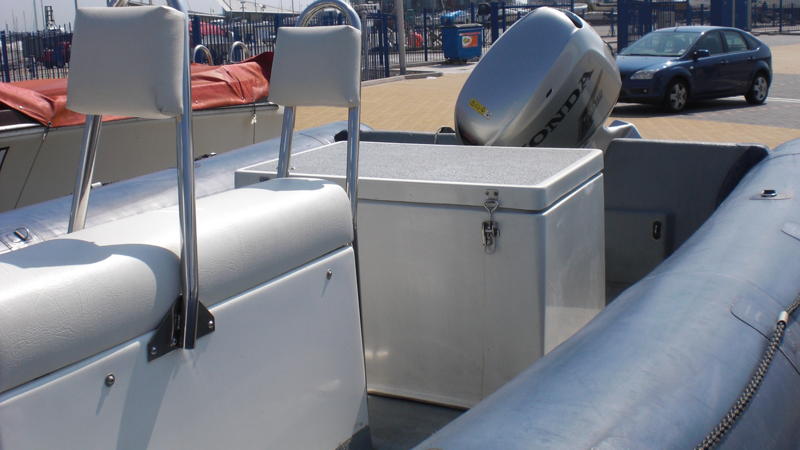

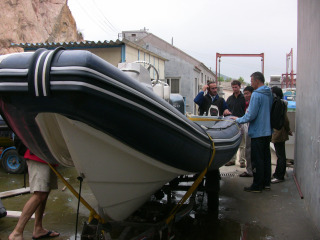
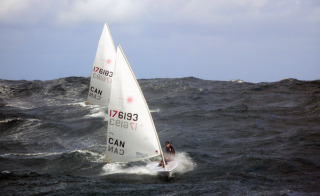
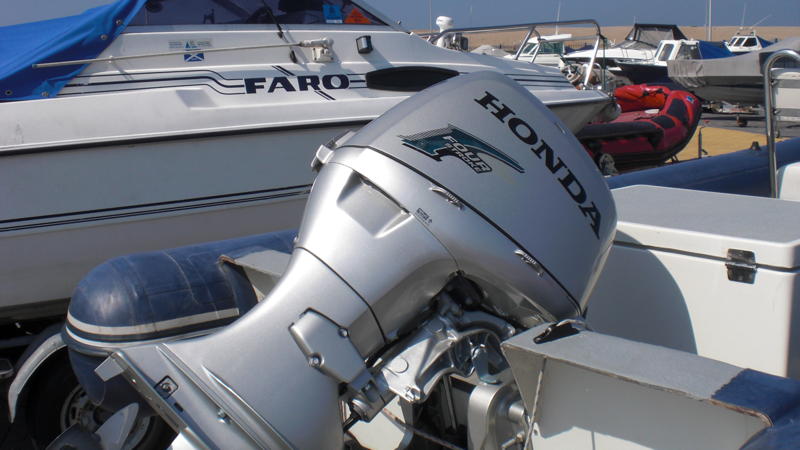
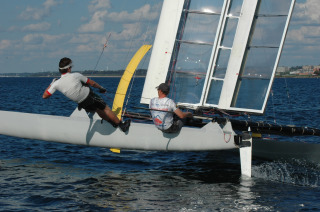
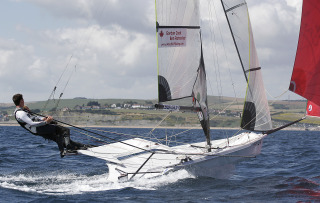
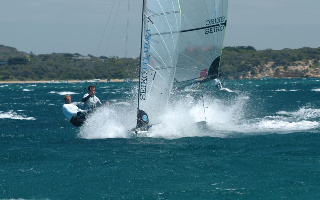
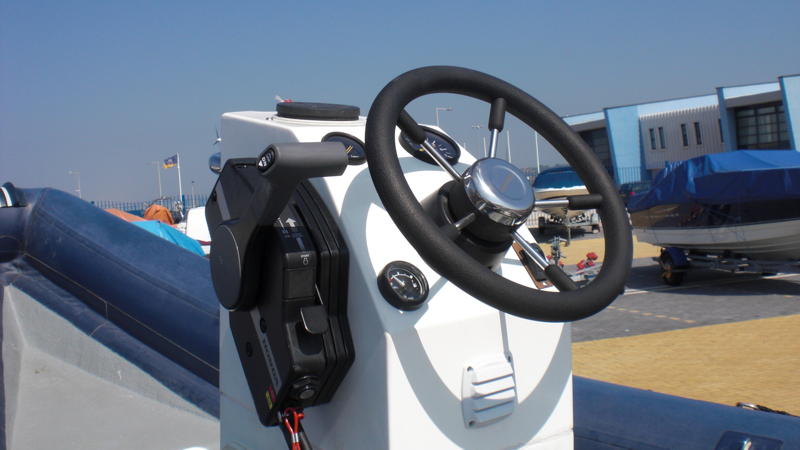
Hello sailors and sailing fans,
Please see the outline below and be ready to picture racing in a slightly different way. Everyone is welcome to click on the title of this blog and add your comments to the discussion.
The Big Picture
One way to increase the media and spectator appeal for sailing it to frame our sport in an accessible venue. As the regatta moves to the final stages, we have seen the top 10 move to a finals format. By advancing that formula, we can enhance the benefits to the media and spectators. See the diagram below, using lane rope to restrict the width of the course it will increase the ability of the media and spectators to see what is going on while at the same time increase the number of tactical situations sailors must navigate.
The concept is to have small fleets race in short courses (9-12 mins) with a width boundary (swim lanes-actual swim lane, like in a pool) to force the fleet into many tactical situations and keep them close together. There would be lots of maneuvering, the aspect ratio will need to be tested, visualize that 8-10 tacks are mandatory per beat!

One alternative for moving sailing forward
Picture grandstands on barges right on the edge of the racecourse with fans able to cheer loud enough for sailors to hear them! Music, a PA system with an announcers, it could all happen in this enclosed venue and the sailors should be able to race unobstructed by the fans.
The style of racing would certainly be very different. Obviously the emphasis on strategic decision making will be vastly reduced with a greater premium on boathandling, tactical decision making, and rising to the occasion. In a couple of cases I think this could be a good showcase for sailing. Yes, it’s not sailing in it’s pure form but I do believe that this would be a fair way to have a winner takes all final race.
While it is hard to say what each class would look like in this format, some obvious candidates come to mind. For example, 49ers would work well as they are spectacular when they do maneuvers and the swim lanes will come into play both up and downwind. Lasers/Radials would also work well as they are so maneuverable and can get into some great tactical situations but swim lanes would only come into play on the upwind. This style of racing may not be a solution for all classes, but may rather just a flourish for a couple of classes to grab media attention and earn some money through ticket sales and TV. The racing should also be pretty spectacular yet still very fair to the sailors!
How to get there?
Here are two format that we have brainstormed that would allow the final stages of racing to be completed in this sailing theatre format. Both of these proposals result in the winner of the final race winning the regatta.
In both of these formats the regatta begins as regattas do currently with open fleet racing creating a low point scoring leaderboard.
Match Race Final Option
The regatta progresses as per normal until the top 10 are known. Instead of a one race final, that top 8 move to a day of ‘theatre racing’
They do 4 – 6 races no discards from these races. Media and spectators can watch as described above. Each race could be scored double points or what ever weighting people want to place on the qualifying.
At the end of the racing the 3 and 4 placed teams match race for the Bronze followed by the 1 and 2 placed team match racing for the Gold.
This way the top sailors rise to the top. There is no randomness and the tv get two shots at exciting racing with the overall winner crossing the line first. The first test of this concept will be tried just ahead of the Sail For Gold Regatta, on August 4th in Weymouth.
“SailorCross” Style Option
To summarize, qualifying is like normal, for example, 3 days of fleet racing. The change comes at the gold/silver fleet split. Instead of gold fleet, the top 24 move on to quarterfinals. (or just the top 12 move on straight to semi finals if there are smaller fleets, like in the Olympics)
Assuming quarterfinals, 4 flights of 6 teams each race off. See the diagram to see how it all looks.
Every team does 4 races in 2 predetermined flights on side by side courses that have swim lanes for boundaries between the courses (see diagram, not to scale). At the end of the day it is scored like a normal day with a ranking from 1 to 24, low points. Finish is at the top, boats sail around the course to get back to the start for the next races to keep things moving. Spectators and Media are right in the action, so long as they aren’t driving up and down the course too much they shouldn’t interfere with the sailors at all.
Top 12 move on to semi finals… and a single course like in the top diagram.
1 – 6 race each other and 7 – 12 race each other. Three races each, only 1 course need be used but swim lanes act as boundary to keep racing tight and allow spectators right close to the action. From 1 – 6, top 3 move to Finals, 4, – 6 move to repachage. From 7 – 12, top 3 move to repachage. The repachage group races 3 races, the top 3 of that move to final. (If racing can not occur after semi finals (wind, etc. 4, 7, 8 move to finals.
Final – 1 race, winner takes all with 6 well qualified boats.
We think that a winner takes all final will be palatable to the sailors in this format as the ‘rewards’ for doing well in qualifying and quarterfinals are cashed in by having a second chance to make the finals instead of by having a points lead in the final. This should allow an excellent day of TV coverage with semi finals, repachage and then finals as a line up, just like they do for snowboardcross.
What do you think?
Ben Remocker and Simon Hiscocks
Looks good….when we team race, we often sail in venues that have limited width, or walls on one side, and it make for much better racing! Espeically if the walls have good wind and water right up to the edge, because then you can sail right up to the wall and tack about a boat length away. The course needs to be aligned to the wind, so you might need barges on each side?
Looks really interesting. I personally feel that the sailor cross format is going a bit to far away from racing as we know it. I appreciate it would be one against one but if you are going to do that I think you risk having to many advantages to one side or the other, possible convergence zones down one side of the course that don’t exist on the opposing teams side caused by spectator crafts. Or a small shift either way would also give one side a very easy option to give the other boat dirty air
With the extreme 40′s we have also done alot of effectively laned racing. We have sailed in venues as narrow as 20 boat widths wide with 10 boats. When the wind gets over a fairly low limit it get’s very full on but it is great fun. A lot of the rules do not work very well with regards to room for the obstructions. When you have 5 boats all calling for room it can get pretty full on for the judges, the crashing potential is also very very large. However, for the spectators watching it has always proved quite easy to understand and they have always seemed to like the fact they can almost touch the boats. I also feel that the number of races in the semi finals format should almost try and outnumber the qualifying number. certainly when we tried something similar in Denmark it was very hard on the guys who got knowcked out after just one finals race having been top of the fleet for 16 fleet races.
Getting the spectators to the racing is a bit of a concern. Are you going to deliver them to barges offshore, where are the barges going to come from ? Would each venue not need them ? How would these be funded ? How about tailoring the venue choices according to the ones that have these natural arenas ? Harbour walls on one side etc.
I think it is great that some new ideas are being banged about. Please can i suggest though that if you are planning to try any of the formats at events in this olympic cycle that you give us good warning before the regatta it effects. All the best
Hi Chris,
Thank you so much for your insight. Your experience in the extreme 40′s is invaluable!
To clear up some confusion on the sailorcross format: we are not proposing that boats on one course race boats on another course. Rather, there would just be two separate courses side by side so that we can run more races quickly and the spectators get more action. It’s not even necessary, but possibly better for the spectators and sailors.
As for the logistics/costs, we’ll have to cross that bridge when/if, as a class we decide it is something we want to do. In testing, however, we would just lay down the boundaries with lane rope and have boats parked on the sidelines. I could imagine a company like red bull sponsoring a barge for fans with their logos everywhere and some TV coverage mounted on the top of the stands, but we’d start out at a much smaller scale.
thanks again for your comments and leadership Chris.
To all the sailors out there, the idea is fantastic but as I have said before on facebook posts there needs to be options in the bag of tools. For example 25 knots in a 49er, EXCITING to watch but not something do-able with grand stands on the side. I believe whether they are put in a sausage format in the middle or square format it needs to be considered. As well as the top 20 teams, as it seems from an outsider looking in they always make it even though they do not have a good series and anyone below that mark has to claw tooth and nail to get anywhere near that mark even if they had a good series. It needs to be about getting the best sailors out and the best sailors in that series not just ranking. The people out of the 20 rank mark still needs a chance to get there. I love all of the ideas that have been put out there and so happy to see that change has been realized. We need the spectators and media promotions to launch sailing to a new level such as red bull or mountain dew etc.
As for spectators the only thing that makes sense to me is put them all on a barge and move them to the course. Ferrying people is not something that is realistic due to the number of spectators you are looking for. How ever this starts it will only grow and will have to be flexible to do so. I look forward to everything that comes about. If anyone wants to contact me I look forward speaking about this further. [email protected]
[...] The first decision is if we go ahead to the ‘trial’ stage for ‘theater style’ racing. [...]
Dear all,
first of all I want to say thank you to Simon, Ben and everyone else who was involved in that brain storming concerning the improvement of the attractiveness and watchability of our sport. But with all due respect to your effort, I do not agree to your proposals.
Actually I don’t really understand why we (49er and olympic sailors in general) are trying to change our sport for media, cause I think there is absolutely no need for. Establishing the Medal Race was anyway a step to the media and has shown to be a good compromise between fairness and thrill with keeping the soul of our sport.
Before we are thinking about something which is changing the whole way of sailing and forces the class to make some big investments for spectators which might most probably are not on sight at least in near future, we should think about what we can do else.
Just think about Medemblik and its positive feedback, also from people which are normally not into sailing. There it was shown it doesn’t need much to bring sailing to the people.
Own GPS tracking + a nice viewer on which you can determine each boat, each team easily + 2-3 cameras on the water and maybe one at a higher venue (at a crane or building or wherever) + and probably most important a good commentator which is from my point of view most crucial to keep the excitement, by the way Richard did a great job in holland.
Of course you can always extend it with onboard cameras and microphones or weather buoys which show you the wind and the current but for the start you don’t need this.
With this tools the class needs to provide packages for the media (like online TV for example http://www.laola1.tv and of course traditional tv stations). I made the experience that if you give TV a full package they are really keen to broadcast it.
For example three packages, first Qualifying summary with highlights + second Final summary with highlights + third Medal Race or however. Of course it should also be possible to watch the racing on the website like the Audi MedCUP Series (www.medcup.org).
If GPS Tracking and some media coverage is working the first potential sponsors we should contact are some betting companies because they are always looking for new stuff to bet on, again you just need to provide the watchability of sailing.
I know that this proposals might be no news for some of you and that Tv production might cost something but if we, the class, wants to invest money to improve our “mediability” this is the way to start.
cheers niko
Hi Niko,
Thanks for weighing in!
I very much appreciate where you are coming from. I too have always wished that the gps tracking would take off so that viewers can ‘watch’ the racing live on the internet. I think there is a tremendous market for that style of fan to become enthralled with our sport. And the best part of that system, is that we get to keep racing the way we like to race. Your guess is as good as mine as to why that has not taken off, maybe one day it will as gps becomes cheaper and cheaper.
The focus of the ‘theater style’ effort, is very much different. This adaptation is very much marketed at the live audience with the possibility of a live TV audience. It’s aim is to capture the energy and action of the racing from close enough to see and feel it.
Both of the proposals have tried to balance the traditional way of racing with the ‘theater style’ concept for the conclusion. This is one of the strongest points of the ‘match race’ option. In that option, only the final day of racing is different from how we normally race. I grant you that it is the most significant day, due to the fact all the winning is done on that day, but there is still a large portion of the racing that is done in the traditional manner. Likewise, with the ‘sailorcross’ style, it is only the last 2 days that are changed.
Thank you for sharing your ideas and thoughts with the community. Your ideas are extremely valid and would be of great benefit to our sport whether we move to a different type of racing or not. As I think more about your proposal, I see the sense in what you are suggesting. One way, we, as a class, could promote the adoption of gps tracking is through our class rules. As a class, we could agree on a gps technology and then add a rule that you must carry that gps transceiver or a piece of lead of equivalent weight. Instead of the class having to bear the total burden of cost and maintaining the equipment, the class could focus on just the receiving and website end. This partnership between the class and each team might be enough to put us over the hump in terms of the internet broadcast ability of the sport and open up a new revenue source for us.
… and now we come to the true issue at heart. Revenue. We call ourselves professional sailors, at least those at the front of the fleet do, but that is not in fact the case for the majority. The truth is that almost all top Olympic sailors rely on a national subsidy for the vast majority of their equipment and travel expenses, not to mention salary, should one be available. For the past 10-15 years this has been a fantastic and stable way to compete at the highest level for a career. There are 2 downsides. a) very few if any of the sailors are able to attract sizable sponsorship package or prize money. b) if the national support were to ever dissapear (think austerity measure Europeans???!!!) then there would be little hope of maintaining the current level of racing or involvement. I personally remember the Canadian system in the 90′s when we went through our austerity period, and it was very tough on all amateur competitors for more than 12 years.
My honest feeling is that while the gps and internet revenues should be pursued, that alone will not be enough to bring our sport up to the professional levels that we might be able to achieve otherwise. With a concentrated, high intensity, easily broadcasted event like ‘theater style’ racing, I think we have a chance.
regards,
Ben
Hi everybody, just trying to clean up this post. I have added the previous comments here, instead of the in the top level thread to keep it easy to maneuver though.
Ben
Since posting the ‘theater style racing’ post, over 400 people have logged in to read it. A thorough compilation of the suggestions will be presented at the 49er Europeans and posted here in a few weeks. In the mean time, I thought I’d pass along 3 comments addressing different issues that readers have written in about.
a) Wind Conditions b) alternate finish style c) alternate qualifying
a) It was commented that with a high aspect ratio racecourse, sailing in 25 knots may not be practical in a 49er. The reader suggested changing the grandstands so that they form a square in the middle of the course for spectators. The racers race like we do currently, with the relatively small obstruction in the middle of the course.
b) Alternate finish. It was suggested that we should simply the finishing format. The suggestion was to have only 2 races once it moves to the top 10. The first race would be ranking 6-10, only the winner advances. Then the winner + rankings 1-5 race off to decide the winner.
My comment on that one is that it sure is simple, but it may not be enough entertainment (~40 mins racing time total) to attract an audience for an event.
c) It was suggested by one of our top sailors that we should modify the qualifying as we modify the finals. The suggestion was to have the top sailors pre-qualified for later rounds of racing.
For example, the regatta would start with all (say) non top 15 ranked teams racing for 2 days. The top (say) 25 would move on. Then the remaining 40 boats would then fleet race for 2 days to get to the top 20. The top 20 would then race off in the sailorcross format from the theater style paper but in fleets of 5 instead of 6.
Keep the suggestions coming everyone. Many suggestions do seem to support the objective of getting fans closer to the racing. Are people OK with restricting the width of the racecourse? Is it worth testing a change in the complexion of current racing in the attempt to increase exposure for sailing. Please weigh in. Remember, we are seeking consensus, a solution that sailors and fans can find a way to support and live with. No single solution will magically appear that will be considered perfect by everyone. But we can work together to try some options that may turn out to be better for everyone.
[...] consensus may be forming about what to do with the ‘theater style’ racing concept! After a review of many of the survey results, there appears to be a consensus [...]
As a co authur I feel I should express some opinions!
For starters I think it is worth wile expressing where the ideas have come from and that process.
Secondly to explain how these ideas might satisfy the criteria.
The route of the ideas stems from a number of places, the winter Olympics demonstarted very well how some sports had changed there formats to radically change there public perception and excitment levels. The ski and border cross were prime examples.
Within the sailing world there have been movements afoot to change the event formats for a number of years, as a class the 49er has always been involved from the early stages in testing concepts. Some were great some were rubbish. The medal race we have currently came from a compromise in these ideas
The various reports that are out from the IOC and recently the Olympic commision highlight the need to change.
If I say we in the rest of this it is semi personal and semi from discussion with various people.
So we have some goals that our events must attempt to meet in broadly order of importance;
Make for a good and fair competition for ALL competitors.
Be fun and easily workable from an event managment perspective.
Test the competitors and produce a worthy champion.
Be easy to follow as a spectator.
Be easy to produce media – tv/ video, tracking, commentry,written, live viewing.
Have a final race.
Have a final race in which the winner is the final winner.
End on the same day for all competitors.
End with a party for competitors, volunteers, friends and family and guests.
Every one go home happy.
So some of this we do very well some it it is very hard to achieve.
The current iteration of ideas stems from trying to satisfy some of these criteria. We think we can satisfy all of the above.
So the idea of restricting the width of the course gives us a boundary that we must race in, it stops the boats getting so far apart, it restricst the leverge boats can geton each other.
Most importantly it gets us lots of crosses and crosses mean we know who is ahead at more times in a race. It makes the bottom line media coverage work by giving a commentator or a youtube videographer something to talk about.
It also creates more manouvers, most sports are about manouvers, great photos come from manouvers mid tack or gybe.
It gives us somewhere that there is pottential for spectators to watch from and gives us more fixed camera positions.
Very likely that it WONT work with large fleets.
Hence the concept of it being a top ten race.
So in our normal racing formats at a class event we would race as per normal in the lead up to the final day. Then instead of one medal race as current we race 4 – 6 medal races, either carry points through or start afresh.
The races are short, on short courses and the course width is narrow.
It will be exciting and there will be incidents and crashes. In 25 knots the winner will be a lot better than we are currently at boat handling or it will be like the bejing medal race!
It is then open to wether these numbers get shorted for a final winner takes all, which personally I see no point in or my personal choice a match race final.
From the results of the medal races 1 and 2 match race for gold and silver and 3rd and 4th match race for bronze and leather. Intense and exciting. Largely fair.
At some events it would remove the easy from ‘easy to manage the races criteria’ a world cup event where currently the medal races take place on a few courses would need the same number of courses as for the fleet racing. But the final match races could be done on one course with multiple classes run consecutively.
There remains the method to close the remaining competitors event down with out these competitors loosing a day, either with one or two more races or a quick race on the restricted course for each group of ten in a smilar format to the current medal race.
So to be a champion in the new format you must demnstrate skills in fleet racing, short course racing ( boat to boat and handling ) and ultimately match racing. It is easy to make good media on that final day and possible for spectators to follow some exciting racing. Every one leaves the event having had a good fun, short course blast around and are all reved up for a party at the end. The local town gets painted red that evening the locals invite the sailors back, legends are made and our sport rocks.
Simon
[...] held a survey to ask our 49er sailors, the people directly affected by the ‘Theater Style’ Racing initiative, what they [...]
[...] and sailors can be in control of how ‘extreme’ the change needs to be, even within the ‘theater style’ [...]
[...] response to the 49er sailors consensus, there will be two tests of ‘Theater Style Racing’ over the next few [...]